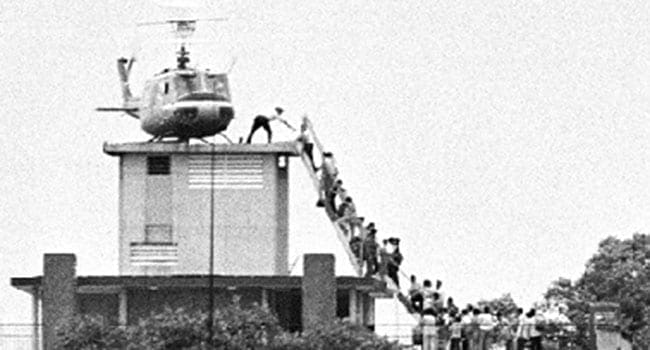 Although it’s been 40 years, the images still pack a dramatic punch. As Saigon fell to the North Vietnamese Army on April 30, 1975, thousands of people – primarily at-risk Vietnamese – were evacuated by helicopter. Two years after the last American troops had departed, the long war was finally over and the reckoning was about to begin.
Although it’s been 40 years, the images still pack a dramatic punch. As Saigon fell to the North Vietnamese Army on April 30, 1975, thousands of people – primarily at-risk Vietnamese – were evacuated by helicopter. Two years after the last American troops had departed, the long war was finally over and the reckoning was about to begin.
Initially, there was a sense of positive anticipation, even giddy celebration, in many Western circles. At the televised Academy Awards ceremony three weeks earlier, Bert Schneider – co-producer of the winning documentary Hearts and Minds – had used his acceptance speech to salute the fact that “Vietnam is about to be liberated,” before going on to read a telegram from the Viet Cong expressing thanks “to all our friends in America” for their assistance. The fact that the self-same Viet Cong had been involved in the killing of some 50,000 American soldiers didn’t seem to dull Schneider’s moment.
Albeit more restrained in tone, the mainstream media generally embraced variations of the same narrative. In The New York Times, a Phnom Penh dispatch from Cambodian correspondent Sydney H. Schanberg ran with the headline “Indochina without Americans: for most, a better life.”
And, of course, there was considerable punditry as to what all this meant for America’s place in the world. Unsurprisingly, the perceived implications were grim. America had been humiliated, Marxist revolution had been vindicated, and the Soviet Union’s relative position and prestige had been strengthened. What Time magazine’s publisher Henry Luce had earlier dubbed the “American Century” was en route to the dustbin.
Then, as it often does, reality intruded.
When Frances Fitzgerald’s 1972 Pulitzer Prize-winning Fire in the Lake called for the flame of revolution to cleanse Vietnamese society, her crystal ball presumably didn’t envision the kind of thing that was actually to happen. Ditto for the journalist who opined that the Vietnamese would now enjoy the “superior social services of the Viet Cong.” In any event, Vietnam after Saigon’s fall didn’t match the hopeful scenarios. Instead, it was characterised by re-education camps, executions and the phenomenon of the boat people, with hundreds of thousands fleeing the country in vessels of varying seaworthiness.
Cambodia, though, was even worse. Whereas Schanberg had believed that Cambodian lives could only get better, what they got instead was the Khmer Rouge’s ideologically motivated purification campaign, which killed around two million people. Despite initial efforts to obfuscate this reality, the truth eventually prevailed.
The prognostications about America’s declining position in the world had more staying power, at least for a while. During Jimmy Carter’s presidency, a post-Vietnam funk combined with various notions of economic decline and insoluble energy shortages to create a vision of an increasingly restricted future. And as Carter struggled, it became fashionable to argue that the presidency was now an impossible job, well beyond the capacity of any single person.
With respect to the conventional wisdom’s grip, the 1980 presidential campaign provided an illuminating moment. When candidate Ronald Reagan ventured the opinion that American involvement in Vietnam had been “a noble cause,” the roof seemed to fall in. He had, the pundits said, committed a major gaffe, so much so that NBC made it the lead item on the evening newscast. Less than three months later, Reagan was elected president in a landslide, which suggests that the conventional wisdom was the product of a pundit-inhabited bubble rather than an accurate reflection of public sentiment.
As for international politics, within 17 years of Saigon’s fall the Soviet Union had disintegrated, thus leaving America as the sole superpower. Somehow, Luce’s “American Century” had its second wind.
This, by the way, doesn’t imply retrospective vindication of America’s military adventure in Vietnam. Although not imperialistic in the classical sense of the term, the intervention was still a fundamental misjudgement. If you combine a misapplication of the 1930’s appeasement lesson with a “can-do” hubris, there’s an excellent chance of it ending in tears. And it did.
There is, however, a useful takeaway. Conventional wisdom can be a precarious guide to reality, especially when its purveyors have a moralistic bent that elides the distinction between analysis and advocacy. And in the modern echo chamber of 24/7 news and social media, the danger is even more acute. On a range of topics, it’s a lesson worth bearing in mind.
Pat Murphy casts a history buff’s eye at the goings-on in our world. Never cynical – well perhaps a little bit.
The views, opinions and positions expressed by columnists and contributors are the author’s alone. They do not inherently or expressly reflect the views, opinions and/or positions of our publication.


